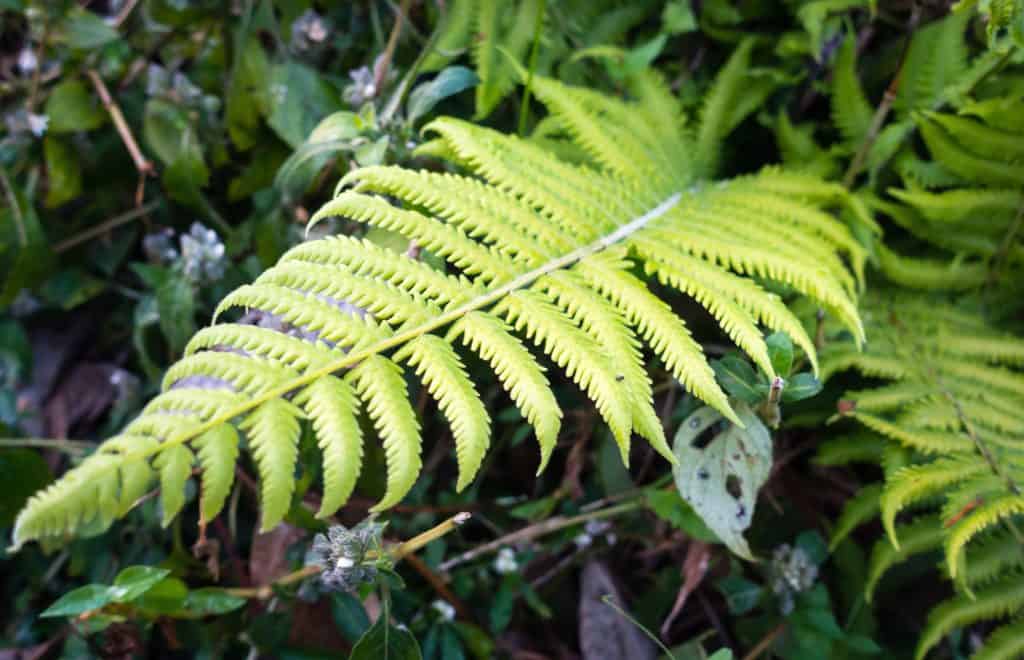The southern Shield Fern botanical name is Thelypteris kunthii. Thelypteris means “female fern.” The species was named to honor the life and work of Karl Sigismund Kunth (1788-1950), a noted German botanist. Southern Shield Fern plants (Thelypteris kunthii) are known by several common names including river fern, Southern Maiden fern, wood fern, and Widespread Maiden fern. West of east Texas it is referred to as river fern as it is only found growing along or near water while east of central Texas, the fern is only found in moist wooded environments and is thus referred to as wood fern. Southern Shield Fern – is evergreen to semi-evergreen, evergreen in frost free areas. Triangular fronds are glossy, dark green in maturity.
If you’re looking for shade lovers that aren’t bothered by deer browsing, try growing a Southern Shield Fern. This fern plant is native from South Carolina to Florida, west into west Texas and south to the Caribbean Islands.
Ferns have a reputation for fussiness, and their cultivation requirements are quite specific. Still, with a little thought and attention, you can successfully grow and maintain them as houseplants. Ferns are not generally invasive, and the majority of varieties do not spread far beyond where they are planted.
Southern Shield Fern Care
When growing Southern Shield ferns select a location that is in shade to partial shade in an area that has average to rich, moist, and preferably good drainage, although shield ferns do tolerate poor drainage. Care of the fern plant is minimal. Water during dry spells and cut back dead fronds prior to spring to encourage new growth.
The Southern Shield Fern Size will reach a height of 1.2m and a spread of 1.2m after 5-10 years.

Lighting Requirement
The Southern Shield Fern prefers bright, indirect light. A few hours of morning sun or gently filtered light through the cover of trees is the perfect scenario. If you have full sun on your front porch, check to see if your side or back porch would provide a less harsh environment for your plants. However, be careful: although ferns are happy residents of shade gardens outdoors, inside they require plenty of bright, indirect light. Exposure to direct sun will burn their delicate foliage, making it dry and brittle and browning the edges.
Soil Type and pH
When planting your Southern Shield Fern, choose a light, fluffy soil mix that contains plenty of organic matter, but not enough to make the soil so heavy and dense that it does not drain well. Most packaged houseplant mediums should work well as long as they are rich in porous organic materials such as peat moss or leaf mold. Adding coarse sand or perlite will allow water to flow through freely. Both plastic and clay pots are suitable for Southern Shield Fern, with those in plastic pots requiring less frequent watering. Pots should be large enough to accommodate the roots with an extra inch of space for further growth. Southern Shield Fern roots tend to be shallow, so short containers are best. Most ferns grow slowly but you should repot when they begin to overcrowd their containers before they become root bound.
Southern Shield Fern can grow up to 36 inches high and 36 inches across. When planting it, make sure that you dig planting holes about 24 inches to 30 inches apart. The holes should be no deeper than that of the root balls. Water the plants in their pots, then plant them, watering more as you go. When planted, the tops of the root balls should be visible; do not bury them under soil.
Southern Shield Ferns can also cope with a wide range of soil Ph from alkaline, neutral to acidic, so checking soil pH before planting isn’t necessary.
Watering & Humidity Requirement
Southern Shield Fern likes moisture. Keep in mind that their natural habitat is under the shady, wet canopy of a rainforest. As a rule of thumb, consistent and evenly moist soil is essential to maintain a bright green, healthy glow. Your watering schedule will depend on how you plant your fern. If you choose to place your fern in a hanging basket or pot, remember that they can dry out quickly. Soil should be kept damp but not wet to the touch. Check your fern daily at first to determine the frequency with which you’ll need to water your ferns.
If grown in the sun, Southern Shield Fern will require regular watering at least one inch per week. When grown in the partial shade or in moist soil, it will only need water every other week. The Shield fern is drought tolerant and can go extended periods of time without water but will not look its best in drought conditions.
Southern Shield Ferns require more water in their first season to help them develop a strong root system and become established. Once the plant has matured slightly, you can reduce watering. If you live in an area that gets a lot of rain, you may find that you don’t need to water your Southern Shield Fern at all.
Proper humidity can be one of the most difficult conditions to provide to the Southern Shield Fern since most of us who live in temperate climates have central heat, which is very drying. Home moisture levels can be desert- like, as low as 5 to 10 percent relative humidity, well below the 40–50 percent levels recommended for Southern Shield Fern.

There are a few simple methods for countering that dryness. Daily watering will help. Resting potted ferns on water-filled saucers or trays that contain a layer of pebbles or broken crockery is another simple way of keeping the humidity high. Just make sure that the bottoms of the pots rest above the water, not in it. Another trick is to place ferns planted in clay pots inside a larger plastic pot lined with a damp, spongey medium such as peat moss. The clay pot will wick the moisture from the peat moss and help prevent the fern soil from drying out. If more moisture is needed, the use of a humidifier near your plants is an option. Drugstore humidifiers are designed to hydrate people, not plants, so there are a few special features to look for when purchasing one. Generous run time is important—select one that can run continuously without refilling for at least 12 hours. Humidifiers have to be cleaned frequently to keep them from spewing salt, mold, or bacteria on your plants, so choose one with a simple design to streamline the chore.
You probably see fern fronds, or leaves, used as fillers in flower arrangements. But don’t let that make you think fern plants will tolerate being packed tightly against a begonia or peace lily in your home. Their delicate leaves are easily broken, and they need plenty of freely circulating moist air to prevent damage and keep them sufficiently hydrated. This is an important point to remember if you decide to use a humidifier. Placing a fan nearby will help disperse the moisture-laden air and keep water droplets from landing on your plants, possibly causing blights and other distressing fern diseases.
Temperature Requirement
The Southern Shield Fern is hardy and can cope with fairly cold weather in the winter. They can be affected by frost and should be moved into a greenhouse during the winter if you live in an area that regularly gets frost or snow.
Fertilization Requirement
Southern Shield Fern does not require regular fertilization. A slow-release fertilizer applied once a year in the spring will suffice. Rather than giving your plant fertilizer, you can use an organic mulch around the base of the plant in the spring. This is particularly beneficial for plants growing in full or partial sun as it will help keep moisture in the soil as well as providing nutrients.
Southern Shield Fern Propagation
Southern Shield Fern is propagated by spores, which are produced around the edges of young fronds in late summer and fall. To grow new ferns, place spore-covered fronds on top of moist peat moss and enclose them in a plastic bag. Make sure the bag has holes to allow airflow. Place the container in a warm area with low light for about one month. Then remove the cover and move it to an area that receives bright indirect sunlight. New ferns should be ready to transplant outdoors in the spring. Southern Shield Fern can also be propagated by division in the spring or summer. These plants grow via rhizome’s which can be separated to create new plants. It’s best to replant individual plants in moist, well-drained soil in an area that gets partial shade.
Southern Shield Fern does not require pruning, but you can trim it back if it spreads too much for your liking. Pruning or cutting back will promote a bushier plant and improve appearance. You can also remove any dead foliage to improve the plant’s appearance.
Common Problems Growing Southern Shield Fern
Southern Shield Fern is generally pest and disease-free. They remain healthy throughout the year but may develop rust-colored spots on the fronds from time to time. Any fungal infections can be controlled with a fungicide.
